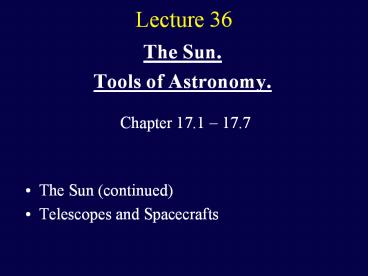The Sun. - PowerPoint PPT Presentation
Title:
The Sun.
Description:
Photons are created in the nuclear fusion cycle. ... The loops rising into the chromosphere or corona may appear as solar prominences. ... – PowerPoint PPT presentation
Number of Views:498
Avg rating:3.0/5.0
Title: The Sun.
1
Lecture 36
- The Sun.
- Tools of Astronomy.
Chapter 17.1 ? 17.7
- The Sun (continued)
- Telescopes and Spacecrafts
2
Hydrogen Fusion in the Sun
The proton-proton chain
3
How does the Light Comes Out?
Photons are created in the nuclear fusion
cycle. They collide with other charged particles
and change their direction (random walk). They
also decrease their energy while walking. It
takes 10 million year to get outside.
The random bouncing occurs in the radiation zone
(from the core to 70 of the Suns radius). At
Tlt2 million K, the convection zone carries
photons further towards the surface.
4
The Suns Internal Structure
5
Solar Neutrino
Neutrino is a subatomic particle. It is a
by-product of the solar proton-proton cycle. It
barely interacts with anything.
Counts of neutrino coming from the Sun are
crucial to test our knowledge about solar physics.
Neutrino observatories use huge amounts of
different substances to detect nuclear reactions
with neutrino. So far theory predicts more
neutrino than is seen.
6
The Super Kamiokande Experiment
Information
Sonic Boom
7
Observations of Solar Neutrino
The GALLEX detector Gran Sasso, Italy
The Sudbury Observatory Ontario, Canada
8
Sunspots and Other Solar Activity
Sunspots have T4,000 K, cooler than the 5,800 K
surrounding plasma.
Sunspots are kept together by strong magnetic
fields. Usually sunspot appear in pairs connected
by a loop of magnetic field lines.
The loops rising into the chromosphere or corona
may appear as solar prominences.
Solar flares are events releasing a lot of energy
where magnetic field lines break.
9
Sunspot Close-Up
10
The Sunspot Cycle
Observations of the Sun since the beginning of
the telescopic era revealed that the number of
sunspots gradually rises and declines.
An average period is 11 years (from 7 to 15
years). The magnetic fields in sunspots reverse
their direction when a cycle is over.
No sunspots were observed in 1645?1715, when a
Little Ice Age took place in Europe and America.
11
The Sunspot Cycle
12
Summary of the Sun
The Sun shines with energy generated by fusion of
hydrogen into helium in its core. Gravitational
equilibrium determines the Suns interior
structure and maintains a steady nuclear burning
rate. The Sun is the only star near enough to
study it in great detail.
13
Collecting Light with Telescopes
Telescopes are giant eyes, collecting more light
than we could with our naked eyes Telescopes are
characterized by 2 key properties
Light-collecting area (depends on the telescope
size) Angular resolution (how much detail we can
see in the telescopes images)
14
Telescope Design
Two basic designs Refracting and Reflecting
telescopes
Refracting telescope uses transparent glass
lenses to focus the light (from Galileos small
telescopes to a 1-m refractor)
15
Refractors
16
Refractors
17
Telescope Design
Reflecting telescopes use precisely curved
mirrors Most contemporary telescopes are
reflectors
Primary mirror gather and focuses the
light Secondary mirror reflects the light to a
convenient location
18
Reflectors
19
Reflectors
20
Uses of Telescopes
Imaging - pictures of celestial
objects Spectroscopy - dispersing light into a
spectrum Timing - tracking time variations of
the light
Atmosphere affects observations - light
pollution, turbulence Turbulence can be corrected
by adaptive optics
21
Types of Telescopes
Optical and Infrared telescopes Radio telescopes
(use metal mirrors) Interferometeres (link
several separate telescopes together to improve
angular resolution)
22
Observatories
23
Radiotelescopes
24
Satellites
- First satellite ? 1957 Soviet Sputnik
- First astronomical satellites ? late 1960s
- The Hubble Space Telescope (HST) ? 1990
- The X-ray Chandra Observatory ? 1999
- The Spitzer Space (IR) Observatory ? 2003
25
Satellites































